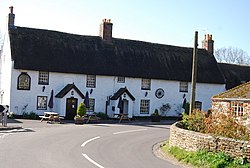East Lulworth
| East Lulworth | |
| Dorset | |
|---|---|
 The Weld Arms, East Lulworth | |
| Location | |
| Grid reference: | SY860822 |
| Location: | 50°38’22"N, 2°11’58"W |
| Data | |
| Population: | 160 |
| Post town: | Wareham |
| Postcode: | BH20 |
| Local Government | |
| Council: | Dorset |
| Parliamentary constituency: |
South Dorset |
East Lulworth is a village nine miles east of Dorchester, near Lulworth Cove, in Dorset.
The village itself consists of 17th-century thatched cottages. It is now dominated by the barracks of the Royal Armoured Corps Gunnery School who use a portion of the Purbeck Hills as a gunnery range: the roads in the area bear a rare warning sign: "Sudden gunfire".
In 2013 the estimated population of the civil parish was 160.
The nearby Lulworth Estate grounds contain the first Roman Catholic chapel to be built since the time of the Protestant Reformation. It was designed in 1786 by John Tasker in the form of a Greek mausoleum at a cost of £2,380.[1] It was the private chapel of the recusant Weld family. The Weld-Blundell family are present-day descendants of the Welds.
The Church of England parish church is dedicated to St Andrew. Only the perpendicular tower and octagonal font are original from the mediæval building, the remainder of the church was built in 1864. It was designed by John Hicks, who also designed East Holme church.
Henry Rolls (1803-1877) was a shoemaker who taught himself to read and write. He kept a journal of the main happenings of village life from 1824 until 1877. After Henry's death, his son George Rolls (1846-1929) continued the journal covering the period from 1877 to 1928. George's daughter Agnes Mary Rolls (1879-1961) then took over responsibility for the journal from 1929 to 1955.
See also
Outside links
- East Lulworth OPC - information on East Lulworth and its residents over the centuries
- Henry Rolls' Journal of Events
- East Lulworth Local History
- Lulworth Online
References
- ↑ Nikolaus Pevsner: The Buildings of England: Dorset, 1972 Penguin Books ISBN 978-0-300-09598-2page 194